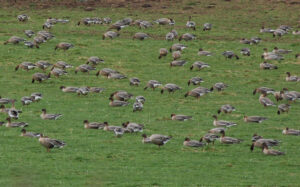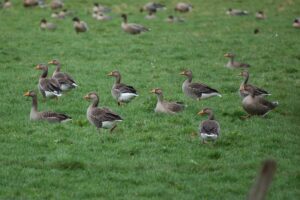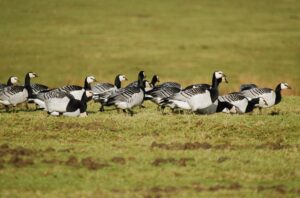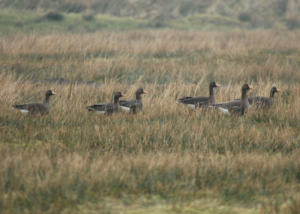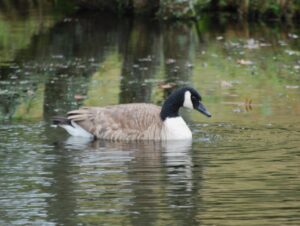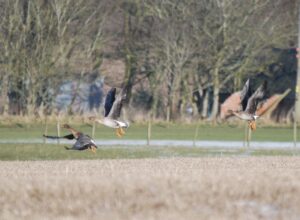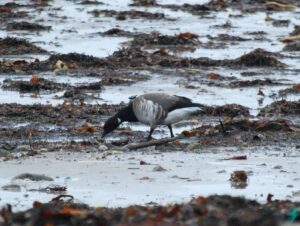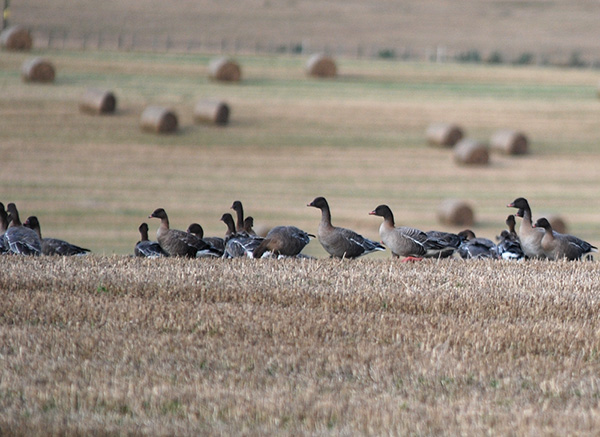Goose Management in Scotland
10 November 2023Summary
- Populations of wintering geese increased dramatically over the past 50 years.
- Resident breeding populations of Greylag and Canada geese continue to increase in many areas.
- Goose grazing leads to conflicts with livestock production and conservation of other species such as Corncrake and waders.
- Scotland supports internationally important numbers of several goose species and has an international obligation to ensure their favourable conservation status.
- A national framework for goose management involving all stakeholders helps to reduce conflict with farming while ensuring that important goose populations are managed sustainably.

Common Goose Species in Scotland
Seven species of geese are regularly found in Scotland. Most are winter visitors, but two species (Greylag and Canada) are present all year round. Most migratory goose species have several distinct sub-populations in different breeding areas, which then migrate to different wintering areas. Conservation management treats these ‘flyway populations’ separately because if one population became extinct it would be unlikely that individuals from a different flyway population of the same species could re-establish the lost population due to their differing migration routes.
How Geese Conflict with Agriculture
In Scotland, most conflicts with agriculture arise from geese grazing on grassland, particularly in late winter and early spring, as this removes early grass growth that is important for livestock production. It is estimated that the grazing of a flock of 1000 geese is equivalent to 200 sheep. Where goose numbers are particularly high, grazing and trampling by geese can lead to destruction of grass swards and prevent the establishment of grass reseeds. These problems are mostly associated with Pink-footed, Greylag and Barnacle geese, although localised impacts from Greenland White-fronted geese occur in some areas. In eastern Scotland, grazing of winter cereal crops by Pink-footed geese also occasionally occurs, but grazing on cereal stubbles, which is the favoured habitat of this species in autumn and early winter, is less likely to cause conflict with agriculture.
The increasing resident population of Greylag geese in many parts of Scotland means that conflict with agriculture has become a year-round problem including damage to silage and cereal crops during spring and summer. Heavy goose grazing can also impact on other wildlife of high conservation value by removing cover for ground-nesting birds such as Corncrake and waders. Resident Canada geese can cause similar problems and may become more of an issue if their populations continue to increase.
Conservation Importance of Geese
Most goose populations in Scotland were reduced to very low levels in the mid-20th Century and the subsequent increases due to legal protection, reduced hunting pressure and the increased availability of productive grassland, represent a significant conservation success story. Although the populations of three species (Pink-footed, Greylag and Barnacle) have increased to the level where it is possible to consider reducing their populations without compromising their overall conservation status, it is important to remember that Scotland supports a very high proportion of the global population or distinct migratory sub-populations of several species, and we have an international obligation to manage them sustainably. The Greenland White-fronted geese remains a globally small and vulnerable population, around half of which winters in Scotland, so reduction of its population is not something that can currently be considered. However, there is no conservation obligation for the Canada goose due to its status as an invasive non-native species.
There is evidence that the population increases of most wintering goose populations have peaked and even declined slightly in recent years. The appearance of High Pathogenicity Avian Influenza (HPAI) is also a new and significant threat. The Barnacle Goose population that winters on the Solway Firth declined by a third in 2021/22 due to an outbreak of HPAI and this remains a threat to other populations where losses have so far been on a smaller scale.
Measures to manage goose impacts must therefore be adaptive and change in response to population changes to ensure that the conservation status of species is not harmed. For migratory species this includes working in partnership with other countries along the population flyway.

Scotland's National Goose Policy Framework
To balance the needs of agriculture and conservation, a National Goose Policy Framework has been in place since 2000, overseen by a National Goose Forum involving key stakeholders representing conservation and farming interests. The core objectives of the policy are to:
- Meet the UK's nature conservation obligations for geese, within the context of wider biodiversity objectives.
- Minimise economic losses experienced by farmers and crofters caused by geese.
- Maximise the value for money of public expenditure on geese management.
Local Goose Management Group and Schemes
Local Goose Management Groups help to co-ordinate and implement action under the National Goose Policy framework in areas of greatest conflict, often through government funded Goose Management Schemes. Schemes focusing on conflicts with over-wintering geese have operated in the past in the following key locations:
- Islay (Barnacle and Greenland White-fronted Geese)
- Kintyre (Greenland White-fronted Goose)
- Uist, Coll and Tiree (Barnacle Goose)
- South Walls, Orkney (Barnacle Goose)
- Solway (Barnacle Goose)
- Loch of Strathbeg, Aberdeenshire (Pink-footed Goose)
NatureScot has details about how to find a goose management group operating in your area as well as the schemes already in existence.
These goose management schemes have mainly focused on providing payments for farmers to provide undisturbed refuge fields for geese to feed in, fertiliser to make these more attractive to geese and non-lethal scaring to discourage the use of non-refuge fields. Licences for lethal scaring have also been issued in some instances as birds can become habituated to non-lethal methods. On Islay, the scheme has also funded marksmen to cull Barnacle geese under license to reduce the population to a more sustainable level.
Culling to reduce populations to a sustainable level has also been the focus of pilot adaptive management schemes aimed at resident Greylag geese in the following four areas:
- Orkney
- Uist
- Lewis & Harris
- Tiree & Coll
In these areas population targets were set and annual cull targets were set based on careful monitoring of population levels and annual breeding productivity. Culling has been carried out by volunteers and paid marksmen.
While many of these schemes have been successful in reducing conflict and goose populations, there are many challenges to overcome. The level of culling required to control highly productive breeding populations of Greylags can be very high and beyond the available resources of volunteers and farmers, while surviving birds can become more wary and difficult to control. Culling by volunteer and paid marksmen in the autumn and winter can also sometimes simply displace existing sport shooting, reducing the benefit. Monitoring of populations and co-ordination of action within local areas also requires resources.
Public funding has an important role to play in supporting goose management schemes due to these challenges, but with resident Greylag and Canada geese increasing in many areas across the country and with public spending constrained, new ways of delivering goose management may be required in future, alongside the much wider changes to agricultural support that are currently being developed.
Paul Chapman, SAC Consulting
Listen to our Thrill of the Hill episode, where we sit down with Rae Mackenzie from NatureScot for a broad discussion on geese and goose management in Scotland:
Sign up to the FAS newsletter
Receive updates on news, events and publications from Scotland’s Farm Advisory Service

